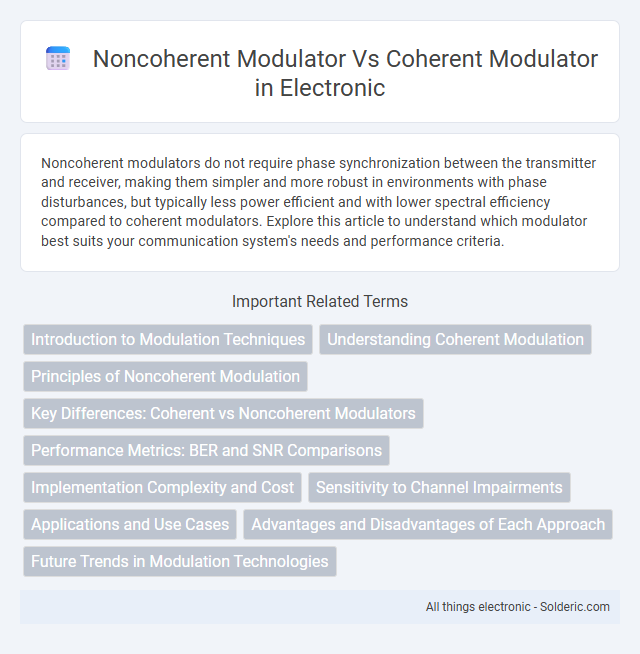Noncoherent modulators do not require phase synchronization between the transmitter and receiver, making them simpler and more robust in environments with phase disturbances, but typically less power efficient and with lower spectral efficiency compared to coherent modulators. Explore this article to understand which modulator best suits your communication system's needs and performance criteria.
Comparison Table
| Feature | Noncoherent Modulator | Coherent Modulator |
|---|---|---|
| Detection Method | Envelope detection without phase reference | Requires exact phase synchronization with the carrier |
| Complexity | Lower complexity, simpler implementation | Higher complexity due to phase synchronization |
| Performance in Noise | Less robust, higher error rates | More robust, better bit error rate (BER) |
| Power Efficiency | Generally lower power efficiency | Higher power efficiency |
| Example Applications | Frequency-shift keying (FSK), On-Off keying (OOK) | Binary phase-shift keying (BPSK), Quadrature phase-shift keying (QPSK) |
| Synchronization Requirement | No carrier phase synchronization required | Requires carrier phase and frequency synchronization |
| Hardware Requirements | Simpler hardware, less processing power | Complex hardware, phase-locked loops, and mixers |
| Latency | Lower latency | May have higher latency due to synchronization |
Introduction to Modulation Techniques
Noncoherent modulators operate without requiring phase synchronization between the transmitter and receiver, making them simpler and more robust in noisy environments. Coherent modulators rely on phase-locked synchronization to accurately demodulate signals, enhancing performance in scenarios demanding high spectral efficiency and lower error rates. Your communication system choice depends on balancing complexity, power consumption, and signal integrity requirements.
Understanding Coherent Modulation
Coherent modulation relies on precise phase synchronization between the transmitter and receiver, enabling accurate demodulation of signals such as PSK and QAM, which results in higher spectral efficiency and better noise performance. Noncoherent modulation, including schemes like FSK and DPSK, operates without the need for phase reference, simplifying receiver design but typically sacrificing performance in terms of error rates and bandwidth usage. Understanding coherent modulation is essential for applications demanding high data rates and reliability, especially in modern wireless communication systems and digital broadcasting.
Principles of Noncoherent Modulation
Noncoherent modulation operates without requiring the receiver to maintain phase synchronization with the transmitter, relying instead on signal characteristics like amplitude or frequency variations. This modulation principle simplifies the design and processing requirements, making it highly suitable for applications with rapidly varying channels or where phase information is unreliable. Understanding these principles can help you select the most efficient modulation technique for scenarios where phase coherence is challenging to maintain.
Key Differences: Coherent vs Noncoherent Modulators
Coherent modulators require precise carrier phase synchronization at the receiver, enabling higher spectral efficiency and better noise immunity, which makes them suitable for complex modulation schemes like PSK and QAM. Noncoherent modulators, by contrast, do not rely on exact phase information, simplifying receiver design and allowing robust performance in fading environments, often used in FSK and ASK systems. The key differences lie in synchronization needs, complexity, and performance trade-offs in noise and fading channels.
Performance Metrics: BER and SNR Comparisons
Noncoherent modulators generally exhibit higher bit error rates (BER) compared to coherent modulators due to the lack of carrier phase information, which reduces their signal-to-noise ratio (SNR) efficiency. Coherent modulators achieve lower BER by utilizing phase synchronization, enabling more accurate demodulation and improved resilience in noisy environments. In scenarios with low SNR, coherent modulation significantly outperforms noncoherent schemes, making it preferable for high-performance communication systems demanding robust error performance.
Implementation Complexity and Cost
Noncoherent modulators have lower implementation complexity and cost due to simpler receiver design, eliminating the need for carrier phase synchronization. Coherent modulators require complex circuitry for accurate phase and frequency recovery, increasing both hardware cost and power consumption. Your choice depends on the trade-off between performance and budget constraints.
Sensitivity to Channel Impairments
Noncoherent modulators exhibit greater robustness to channel impairments such as phase noise and frequency offset, making them suitable for environments with rapidly varying or uncertain channel conditions. Coherent modulators, while offering higher spectral efficiency and better noise performance under ideal synchronization, are more sensitive to impairments like phase distortion and Doppler shifts, requiring precise channel estimation and tracking. Your choice between these modulators depends on the trade-off between system complexity and tolerance to channel impairments.
Applications and Use Cases
Noncoherent modulators are widely used in low-power, low-complexity wireless communication systems such as RFID and sensor networks, where phase synchronization is challenging or unnecessary. Coherent modulators dominate applications demanding high data rates and spectral efficiency, including LTE, 5G, and satellite communications, due to their ability to efficiently decode phase information for improved error performance. Noncoherent schemes excel in scenarios with rapid phase variations or limited processing capabilities, whereas coherent schemes are preferred in environments with stable carrier phase and stringent performance requirements.
Advantages and Disadvantages of Each Approach
Noncoherent modulators offer simpler designs and lower implementation costs by eliminating the need for carrier phase synchronization, making them ideal for applications with limited processing power. However, their disadvantage lies in reduced sensitivity and higher error rates compared to coherent modulators, which use phase information to achieve better noise immunity and improved signal detection. Your choice between noncoherent and coherent modulation depends on balancing system complexity, performance requirements, and environmental conditions.
Future Trends in Modulation Technologies
Future trends in modulation technologies indicate a growing emphasis on coherent modulators due to their superior spectral efficiency and robustness in high-data-rate communication systems such as 5G and beyond. Noncoherent modulators remain relevant for low-complexity, low-power IoT devices and short-range wireless applications where cost and implementation simplicity are critical. Advances in digital signal processing and machine learning are expected to enhance coherent modulation performance, enabling adaptive modulation schemes that optimize data throughput and reliability in dynamic channel conditions.
Noncoherent modulator vs coherent modulator Infographic

 solderic.com
solderic.com